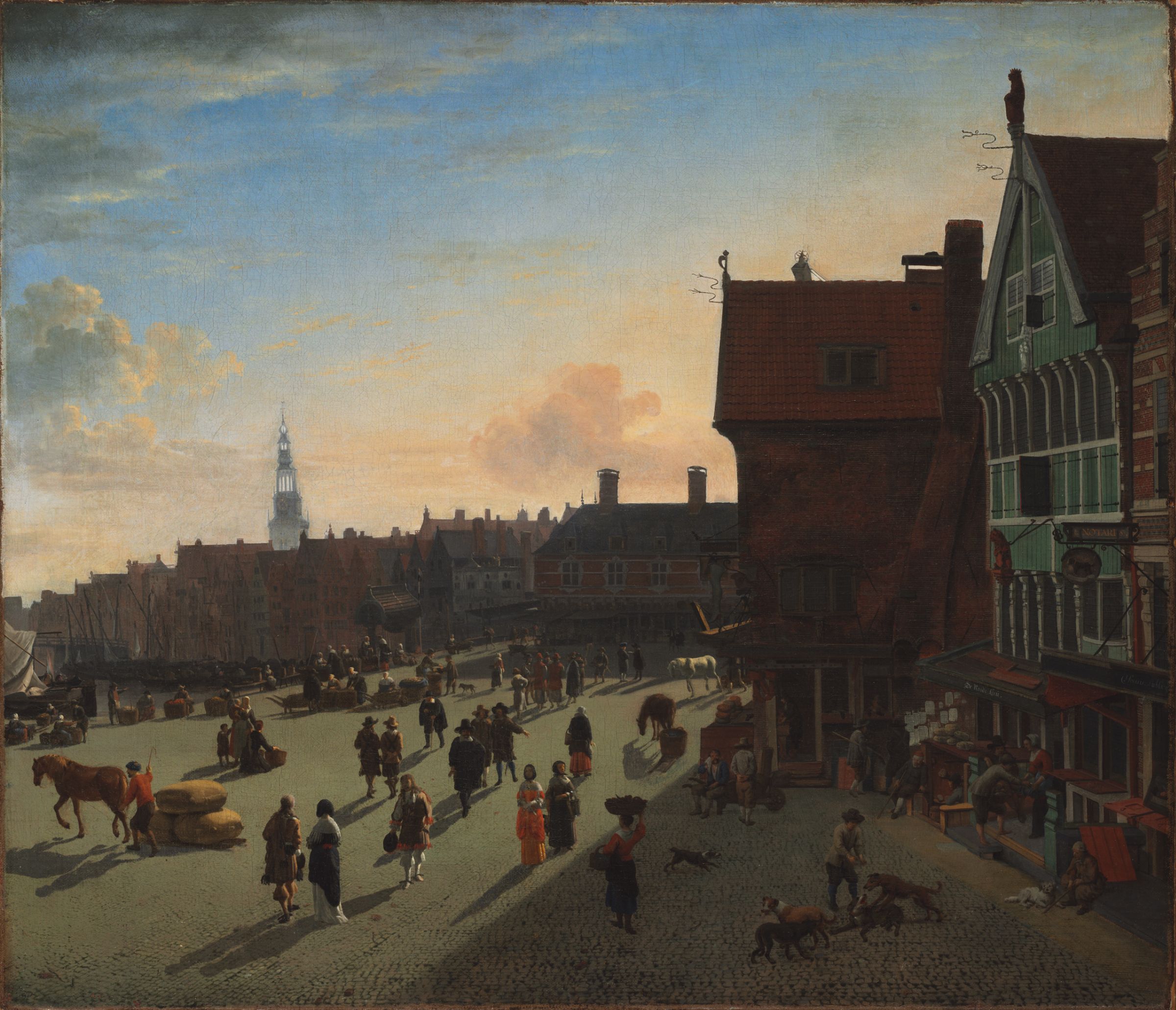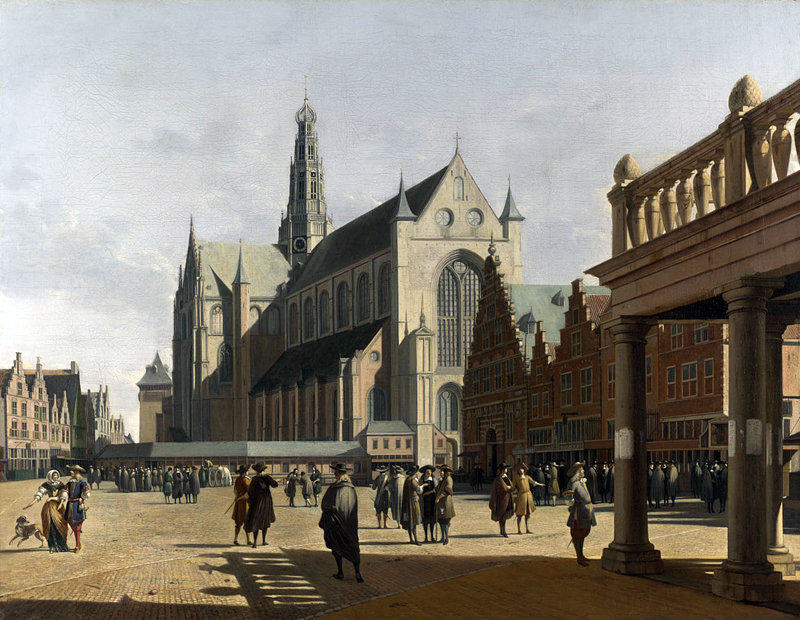INTRODUCTION
The Grounds of a Baroque Palace
Jan van der Heyden, Public domain, via Wikimedia Commons
Jan van der Heyden (1637–1712) is one of the Dutch Golden Age’s most celebrated painters of urban architecture and townscapes.
Trained as a painter and inventor (he improved firefighting equipment and hydraulic devices), van der Heyden translated the hard geometry of city buildings, canals, and bridges into paintings that balance documentary clarity with a quietly staged human drama.
His works are valued today both for their technical finish and for the window they provide onto 17th-century urban life. This essay examines five key paintings, compares van der Heyden’s approach with two similar works by other artists, and analyzes his color palette, recurring subjects, present display locations, and typical market valuations.
Five key paintings

The Dam and Damrak, Amsterdam
Jan van der Heyden, Public domain, via Wikimedia Commons

Jan van der Heyden, Public domain, via Wikimedia Commons
1. The Dam and Damrak, Amsterdam (c. 1663)
This view captures one of Amsterdam’s principal civic axes—the Dam and the Damrak—from a slightly unusual vantage point that concentrates on everyday activity along the water.
The composition demonstrates van der Heyden’s characteristic combination of measured architectural perspective, crisp drawing of façades, and the animated human vignettes at canal level: boats, merchants, and passersby who populate the city.
The work’s careful depiction of reflections in the water and the fine detail on gables reveal his patience of observation.
Why it matters: the painting is both a topographical record and a crafted composition—van der Heyden rearranges and compresses views for pictorial effect while retaining documentary clarity.
2. Amsterdam City View with Houses on the Herengracht and the Old Haarlemmersluis (c. 1670)
This piece shows van der Heyden’s interest in the interplay between canals, locks, and contiguous housefronts. The scene is notable for its hybrid character: while topographically accurate in parts, the artist recombines structures to create an idealized city stretch that foregrounds aligned façades and the engineered hydraulics of the lock. The painting highlights his handling of a close-up urban perspective—the viewer almost stands at the waterline—and his layering of small staffage (figures and boats) to animate the scene.
Why it matters: it exemplifies van der Heyden’s skill at compressing real architectural elements into cohesive vistas that serve both topography and pictorial order.
3. The Herengracht, Amsterdam, Viewed from the Leliegracht (c. 1660–1670)
Here van der Heyden turns his attention to one of Amsterdam’s most prestigious canals, the Herengracht. The vantage point from the Leliegracht yields a layered, receding composition of housefronts and bridges, with the canal acting as a reflective axis. The painting foregrounds van der Heyden’s hallmark: sharply delineated architectural lines rendered with thin, precise brushwork, paired with lively small-scale human activities—fishermen, pedestrians, and domestic boats.
Why it matters: it is a representative example of the artist’s mature canal views, demonstrating an economy of means and a focus on urban texture.
4. Dam Square, Amsterdam (c. 1668)
Van der Heyden’s view of the Dam Square concentrates on the civic heart of Amsterdam, its market life, and its monuments.
The painting captures the dignity of public architecture and the hustle of civic spaces: market stalls, carriages, and citizens moving across the square.
As in his other works, a calm, almost editorial eye organizes significant architectural features into a readable, rhythmically balanced composition.
Why it matters: it places van der Heyden among the best of Dutch townscape painters who could turn civic architecture into narrative stage sets without sacrificing topographical interest.

View of the Westerkerk, Amsterdam
Jan van der Heyden, Public domain, via Wikimedia Commons
5. View of the Herengracht, Amsterdam (c. 1670—private or circulating collection)

Jan van der Heyden, Public domain, via Wikimedia Commons
Another iteration of the Herengracht motif, this painting emphasizes the long sweep of the canal, the rhythm of gables, and the carefully modeled reflections.
It is an excellent example of the variants van der Heyden painted of similar locations—each variant tweaks perspective, light, or staffage to produce a distinct atmosphere. Many such works reside today in private collections or travel through the auction market.
Why it matters: it shows how van der Heyden repeatedly returned to the same motifs as if to study permutations of light, composition, and civic life over time.
Two comparative works by other artists

Market Place and Grote Kerk at Haarlem {{PD-US}}
Gerrit Berckheyde, Public domain, via Wikimedia Commons
A. Gerrit Berckheyde—The Market Place and the Grote Kerk at Haarlem (1674)

Gerrit Berckheyde, Public domain, via Wikimedia Commons
Gerrit Berckheyde, a near-contemporary, specialized in luminous views of provincial Dutch towns (notably Haarlem).
His Market Place and the Grote Kerk at Haarlem share van der Heyden’s interest in civic architecture and humanized public squares.
However, Berckheyde often employs a warmer, sunlit palette and emphasizes open-air atmosphere and monumental church façades, while van der Heyden typically focuses on complex canal perspectives, crisp linearity, and a cooler, more restrained light.

A Grand Canal View
Canaletto, Public domain, via Wikimedia Commons
B. Canaletto—a Grand Canal view (18th century)

Canaletto, Public domain, via Wikimedia Commons
Canaletto’s Venetian vedute present an instructive contrast. Like van der Heyden, Canaletto is a master of architectural precision and of composing waterborne reflections and human figures.
However, Canaletto’s light is Mediterranean and often theatrical; his scale tends toward panoramic, and his vedute were made for a Grand Tour market that prized recognizable monuments. Van der Heyden’s townscapes are more intimate and infrastructural: canals, locks, and bridges rather than grand palaces and piazzas.
Color palette and technique
Palette
Van der Heyden’s palette is characteristically cool and restrained, derived from the northern European daylight: ultramarine (or azurite substitutes), lead white, earth tones (ochres and umbers), and restrained greens for foliage and canal water. His skies are often pale, layered with thin glazes to achieve subtle gradations; architecture is modeled with clean, near-dry brushwork that emphasizes edges and geometry rather than painterly texture. Highlights—window glints, boat hulls, and gilded architectural details—are added with a precise hand, usually in a warmer white or pale yellow to create contrast.
Brushwork and layering
Technically, van der Heyden favors thin, exact strokes and careful underdrawing. He often painted on wood panels or fine canvases with an initial ground that allowed crisp line work. Finishing touches are delicate: small human figures are often painted with a few economical strokes, while architectural ornament receives minute attention. The result is a surface where line and plane dominate over painterly impasto—a measured, almost draughtsman-like approach that echoes his interest in precision and engineering.
Subjects and recurring motifs
-
Canals and locks
-
Housefronts and gables
-
Reflections and waterborne activity
-
Small staffage
-
Civic centers
These motifs reinforce van der Heyden’s dual impulse: the desire to document and the desire to compose. He often edited reality to improve legibility, sometimes moving buildings or recombining elements to create a more balanced picture.
Where these works are displayed today
-
The Dam and Damrak, Amsterdam—held in a prominent museum collection.
-
Amsterdam City View with Houses on the Herengracht and the old Haarlemmersluis—in a major national collection.
-
The Herengracht, Amsterdam, Viewed from the Leliegracht—part of a large European painting collection in Los Angeles.
-
Dam Square, Amsterdam—preserved in a municipal or historical collection.
-
View of the Herengracht, Amsterdam—examples are found in both public and private collections.
Note: Museum holdings rotate; not all works are permanently on view.
Valuations and market behavior
-
Auction prices: smaller works and uncertain attributions sell at modest prices, while fully attributed, well-provenanced townscapes can reach mid-five-figure to six-figure results.
-
Value drivers: secure attribution, condition, appealing subjects (major Amsterdam views), and provenance.
-
Market variability: not as stratospheric as Rembrandt or Vermeer, but consistently desirable among collectors of townscapes.
How to evaluate a Jan van der Heyden painting
-
Provenance
-
Attribution
-
Condition
-
Subject and rarity
-
Documentation
Final assessment
Van der Heyden combined an engineer’s eye with a painter’s craft. His topographical accuracy, balanced by compositional invention, created townscapes that are both historical documents and works of art. Compared with Berckheyde and Canaletto, he stands out for his cooler palette, infrastructural focus, and documentary impulse. His works remain valuable to museums and collectors alike, with steady demand on the art market.
Keywords: Jan van der Heyden paintings, Dutch Golden Age townscapes, Herengracht, Damrak, Amsterdam city view, art valuation, museum locations, color palette, architectural painting